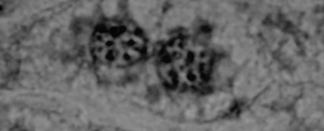Article contents
Effects of Iron Oxide Nanoparticles on Structural Organization of Hepatocyte Chromatin: Gray Level Co-occurrence Matrix Analysis
Published online by Cambridge University Press: 27 May 2021
Abstract

Gray level co-occurrence matrix (GLCM) analysis is a contemporary and innovative computer-based algorithm that can be used for the quantification of subtle changes in a cellular structure. In this work, we use this method for the detection of discrete alterations in hepatocyte chromatin distribution after in vivo exposure to iron oxide nanoparticles (IONPs). The study was performed on 40 male, healthy C57BL/6 mice divided into four groups: three experimental groups that received different doses of IONPs and 1 control group. We describe the dose-dependent reduction of chromatin textural uniformity measured as GLCM angular second moment. Similar changes were detected for chromatin textural uniformity expressed as the value of inverse difference moment. To the best of our knowledge, this is the first study to investigate the impact of iron-based nanomaterials on hepatocyte GLCM parameters. Also, this is the first study to apply discrete wavelet transform analysis, as a supplementary method to GLCM, for the assessment of hepatocyte chromatin structure in these conditions. The results may present the useful basis for future research on the application of GLCM and DWT methods in pathology and other medical research areas.
- Type
- Biological Applications
- Information
- Copyright
- Copyright © The Author(s), 2021. Published by Cambridge University Press on behalf of the Microscopy Society of America
References
- 8
- Cited by





